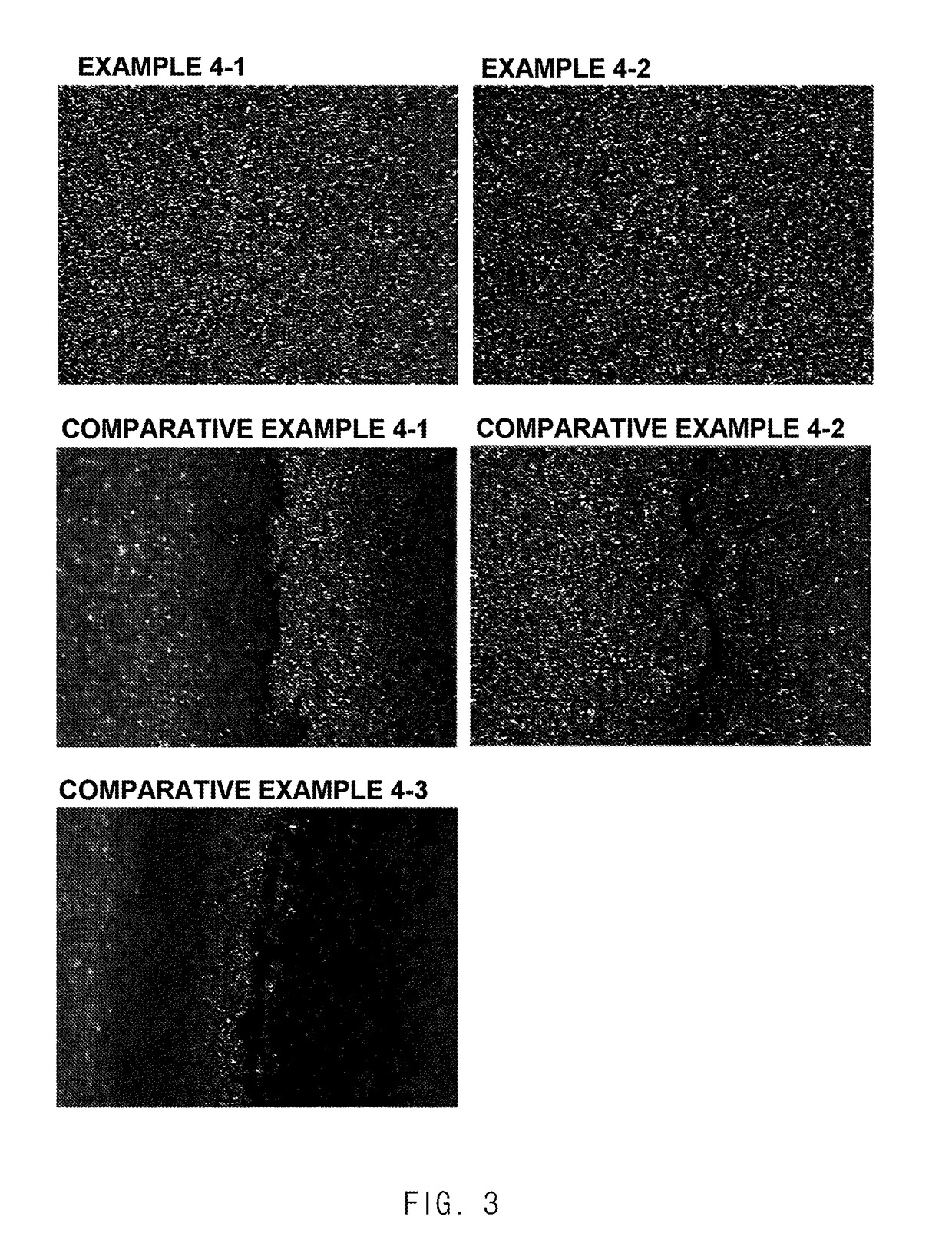Conductive material dispersed liquid and lithium secondary battery manufactured using same
a technology of conductive materials and lithium secondary batteries, which is applied in the direction of batteries, sustainable manufacturing/processing, cell components, etc., can solve the problems of limited use of carbon nanotubes, aggregation phenomenon, and carbon nanotubes that do not stably disperse, so as to improve the performance characteristics, particularly capacity characteristics, and high capacity. , the effect of high solid-like properties
- Summary
- Abstract
- Description
- Claims
- Application Information
AI Technical Summary
Benefits of technology
Problems solved by technology
Method used
Image
Examples
example 1-1
Preparation of Bundle-Type Carbon Nanotubes
[0148]2,424 g of Co(NO3)2.6H2O and NH4VO3 (Co / V, a molar ratio of 10:1) as precursor materials of Co and V was added to 2,000 ml of water, and thereby a clear aqueous solution was prepared in a flask A.
[0149]Separately, 2,000 g of an α-alumina support obtained by primary calcination of aluminum hydroxide (Al(OH)3) as an aluminum-based support precursor at 500° C. for 4 hours was prepared in a flask B.
[0150]4,424 g of the flask A solution was added to the flask B such that Co / V (a molar ratio of 10:1) was 30 mol when 2,000 g of the alumina support was converted into 100 on a molar basis. Further, citric acid was added such that Co was 23 mol with respect to 1 mol of citric acid, and the weight of the resultant mixture was weighed and aged while stirring for 5 minutes in a 60° C. thermostat to sufficiently support the graphite catalyst metal precursor. While maintaining the above temperature, the aged mixture was vacuum-dried while rotating a...
experimental example 1-1
[0154]The shape of the secondary structure, average strand diameter, average strand diameter and average length of the carbon nanotube unit (CNT unit), a BET specific area, a bulk density and a true density of bundle-type carbon nanotubes of Example 1-1 and entangled-type carbon nanotubes of Comparative Example 1-1 each were measured in the following manner, and the results are shown in the following Table 1.
[0155]1) The shape of the secondary structure and particle size: the particle size and the shape of the secondary structure of the CNT were observed using a scanning electron microscope (SEM).
[0156]2) Average diameter of CNT unit: the average diameter of a carbon nanotube unit was measured using an SEM and BET.
[0157]3) Average length of CNT unit: the average length of a carbon nanotube unit was measured using an SEM.
[0158]4) BET specific surface area: the BET specific surface area was calculated from the adsorption amount of nitrogen gas at a liquid nitrogen temperature (77 K) u...
examples 2-1 and 2-2
, AND COMPARATIVE EXAMPLES 2-1 TO 2-3
Preparation of Conductive Material Dispersed Liquid
[0161]Compositions, shown in the following Table 2, containing 5 wt % of the carbon nanotubes, 1.0 wt % of the dispersant, and 94 wt % of the dispersion medium based on the total weight of the composition were mixed for 60 minutes using a homogenous mixer (VMA LC55, Impeller / 3,000 rpm). The resultant mixture was circulated for a period of time shown in the following Table 2 using a bead mill (NETZSCH Mini-cer, bead size: 1 mm / 3,000 rpm) to obtain the conductive material dispersed liquids including bundle-type carbon nanotubes of Examples 2-1 and 2-2, and Comparative Examples 2-1 to 2-3.
TABLE 2CarbonDispersionClassificationnanotubesDispersantmediumMilling timeExample 2-1Example 1-1H-NBRNMP60 minutesExample 2-2Example 1-1H-NBRNMP90 minutesComparativeExample 1-1H-NBRNMP30 minutesExample 2-1ComparativeExample 1-1H-NBRNMP45 minutesExample 2-2ComparativeComparativeH-NBRNMP60 minutesExample 2-3Example 1...
PUM
| Property | Measurement | Unit |
|---|---|---|
| frequency | aaaaa | aaaaa |
| phase angle | aaaaa | aaaaa |
| diameter | aaaaa | aaaaa |
Abstract
Description
Claims
Application Information
 Login to View More
Login to View More - R&D
- Intellectual Property
- Life Sciences
- Materials
- Tech Scout
- Unparalleled Data Quality
- Higher Quality Content
- 60% Fewer Hallucinations
Browse by: Latest US Patents, China's latest patents, Technical Efficacy Thesaurus, Application Domain, Technology Topic, Popular Technical Reports.
© 2025 PatSnap. All rights reserved.Legal|Privacy policy|Modern Slavery Act Transparency Statement|Sitemap|About US| Contact US: help@patsnap.com



